อิทธิพลของความกังวลด้านความเป็นส่วนตัวและความคุ้มค่าที่มีต่อความตั้งใจในการใช้สายรัดข้อมือเพื่อสุขภาพเมื่อกำกับความสัมพันธ์ด้วยการซื้อสินค้าด้วยเงื่อนไขพิเศษและความสนใจในนวัตกรรมส่วนบุคคลที่ส่งผลต่อความตั้งใจในการใช้ที่มีต่อความเต็มใจที่จะจ่ายเงินและเปิดเผยข้อมูลส่วนบุคคล
Main Article Content
บทคัดย่อ
บทความวิจัยนี้มีวัตถุประสงค์เพื่อศึกษาถึงอิทธิพลของตัวแปรสาเหตุและตัวแปรผลลัพธ์ เมื่อควบคุมตัวแปร ความคาดหวังจากประสิทธิภาพ ความคาดหวังในความพยายามใช้งาน ความสอดคล้องในการใช้งาน และแรงจูงใจที่สนุกสนานเพลิดเพลินที่มีผลต่อความตั้งใจในการใช้สายรัดข้อมือเพื่อสุขภาพ เป็นการวิจัยแบบผสาน ด้วยการวิจัยเชิงปริมาณใช้ ตัวอย่างจำนวน 338 คน ใช้สถิติวิเคราะห์ตัวแบบสมการโครงสร้าง และการวิจัยเชิงคุณภาพ สัมภาษณ์เชิงลึกกับผู้เชี่ยวชาญ จำนวน 5 คน และสัมภาษณ์กลุ่ม จำนวน 4 คน และวิเคราะห์ข้อมูลด้วยการวิเคราะห์เนื้อหา
ผลการวิจัย พบว่า การซื้อสินค้าด้วยเงื่อนไขพิเศษ ไม่มีอิทธิพลกำกับความสัมพันธ์ระหว่างความกังวลด้านความเป็นส่วนตัวกับความตั้งใจในการใช้สายรัดข้อมือเพื่อสุขภาพ แต่มีอิทธิพลทางตรงอย่างมีเงื่อนไข อย่างไรก็ตาม ความสนใจในนวัตกรรมส่วนบุคคล มีอิทธิพลกำกับความสัมพันธ์ระหว่างความคุ้มค่า กับความตั้งใจในการใช้สายรัดข้อมือเพื่อสุขภาพ และมีอิทธิพลทางตรงอย่างมีเงื่อนไข พบอีกว่า ความตั้งใจในการใช้สายรัดข้อมือเพื่อสุขภาพมีอิทธิพลทางตรงในเชิงบวกต่อความเต็มใจที่จะจ่ายเงินและความเต็มใจที่จะเปิดเผยข้อมูลส่วนบุคคล อย่างมีนัยสำคัญทางสถิติ ทั้งนี้ เป็นจริงทั้งก่อนและหลังควบคุมปัจจัย 4 ตัวแปร
Article Details
บทความวิชาการ บทความวิจัย และบทวิจารณ์หนังสือในวารสารดุษฎีบัณฑิตทางสังคมศาสตร์ เป็นความคิดเห็นของผู้เขียน มิใช่ของคณะผู้จัดทำ และมิใช่ความรับผิดชอบของสมาคมปรัชญาดุษฎีบัณฑิตทางสังคมศาสตร์ มหาวิทยาลัยรามคำแหง (กรณีการทำวิจัยในมนุษย์ ผู้วิจัยต้องผ่านการอบรมจริยธรรมการวิจัยในมนุษย์ และนำหลักฐานมาแสดง)
เอกสารอ้างอิง
Accenture. (2014). The Internet of things: The future of consumer adoption. Retrieved from https://rb.gy/xuguax
Agarwal, R., & Prasad, J. (1998). A conceptual and operational definition of personal innovativeness in the domain of information technology. Information Systems Research, 9(2), 204-215.
Buchanan, T., Paine, C., Joinson, A. N., & Reips, U. D. (2007). Development of measures of online privacy concern and protection for use on the Internet. Journal of the American Society for Information Science and Technology, 58(2), 157-165.
Chantavanich, S. (2016). Data analysis in qualitative research (12th ed.). Chulalongkorn University Press. [In Thai]
Chaveesuk, S., & Vongjaturapat, S. (2012). Theory of information technology adoption. KMITL Information Technology Journal, 1(1), 1-21. [In Thai]
Davis, F. D. (1985). A technology acceptance model for empirically testing new end-user information systems: Theory and results. Unpublished doctoral dissertation, Massachusetts Institute of Technology.
Dinev, T., & Hart, P. (2006). An extended privacy calculus model for e-commerce transactions. Information Systems Research, 17(1), 61-80.
Gall-Ely, M. L. (2009). Definition, measurement and determinants of the consumer’s willingness to pay: A critical synthesis and directions for further research. Recherché et Applications Marketing, 24(2), 91-113.
Gao, Y., Li, H., & Luo, Y. (2015). An empirical study of wearable technology acceptance in healthcare. Industrial Management & Data Systems, 115(9), 1704-1723.
Hayes, A. F. (2017). Introduction to mediation, moderation, and conditional process analysis: A regression-based approach (2nd ed.). Guilford.
Huber, F., Vollhardt, K., Matthes, I., & Vogel, J. (2010). Brand misconduct: Consequences on consumer-brand relationships. Journal of Business Research, 63(11), 1113-1120.
Jeong, N., Yoo, Y., & Heo, T. Y. (2009). Moderating effect of personal innovativeness on mobile-RFID services: Based on Warshaw’s purchase intention model. Technological Forecasting and Social Change, 76(1), 154-164.
Jianlin, W., & Qi, D. (2010). Moderating effect of personal innovativeness in the model for e-store loyalty. In 2010 International Conference on E-Business and E-Government (pp. 2065-2068). IEEE.
Kowatsch, T., & Maass, W. (2012). Critical privacy factors of internet of things services: An empirical investigation with domain experts. Paper presented at the conference on the 7th Mediterranean Conference on Information Systems, MCIS 2012. Guimaraes, Portugal.
Kumar, P. N., Ali, F., & Leong, L. C. (2015). Factor affecting acceptance & use of rewind: Validating the extended unified theory of acceptance and use of technology. Interactive Technology and Smart Education, 12(3), 183-201.
Lichtenstein, D. R., Netemeyer, R. G., & Burton, S. (1990). Distinguishing coupon proneness from value consciousness: An acquisition-transaction utility theory perspective. Journal of Marketing, 54(3), 54-67.
Moon, Y. (2016). Statistical of effect of extended UTAUT variables on user acceptance of smart wearable devices and use behavior. Journal of Computer Science and Information Engineering, 3(3), 16-22.
Nunnally, J. C. (1967). Psychometric theory. McGraw-Hill.
Piriyakul, M. (2020). Sample size determination for Structural Equation Modeling (SEM). Retrieved from http://www.research.ru.ac.th/images/ArticleMr/1544072259_Article.pdf [In Thai]
Sarkarm, S., & Khare, A. (2017). Moderating effect of price perception on factors affecting attitude towards online shopping. Journal of Marketing Analytics, 5(2), 68-80.
Singh, S. (2015). Consumer behavioural intentions toward Internet marketing. Global Journal of Science Frontier Research: Einterdiciplinary, 15(1), 1-16.
Swaminathan, S., & Bawa, K. (2005). Category-specific coupon proneness: The impact of individual characteristics and category-specific variables. Journal of Retailing, 81(3), 205-214.
Thaler, R. (1985). Mental accounting and consumer choice. Marketing Science, 4(3), 199-214.
Van der Heijden, H. (2004). User acceptance of hedonic information systems. MIS Quarterly, 28(4), 695-704.
Venkatesh, V., Morris, M. G., Davis, G. B., & Davis, F. D. (2003). User acceptance of information technology: Toward a unified view. MIS Quarterly, 27(3), 425-478.
Venkatesh, V., Thong, J. Y. L., & Xu, X. (2012). Consumer acceptance and use of information technology: Extending the unified theory of acceptance and use of technology. MIS Quarterly, 36(1), 157-178.
Weinswig, D. (2016). Wear 2016: Wearable tech, data and style. Retrieved from https://www.deborahweinswig.com/wear-2016-wearable-tech-data-and-style
Yang, L., Yang, S. H., & Plotnick, L. (2013). How the Internet of things technology enhances emergency response operations. Technological Forecasting and Social Change, 80(9), 1854-1867.
Yan, Z., Zhang, P., & Vasilakos, A. V. (2014). A survey on trust management for internet of things. Journal of Network and Computer Applications, 42, 120-134.


